by Wanda Carter
I'm a bulk cooker and one of the types of sessions I do is freezing potatoes. When potatoes go on sale, I buy at least 20#-frequently 60# or more. I never buy potatoes unless they are on sale, and I never have to deal with watching them slowly go bad in the dark recesses of my pantry because I can't use them fast enough.
TheHomeSchoolMom may earn affiliate commissions from purchases made using links on this page. Read our full disclosure.
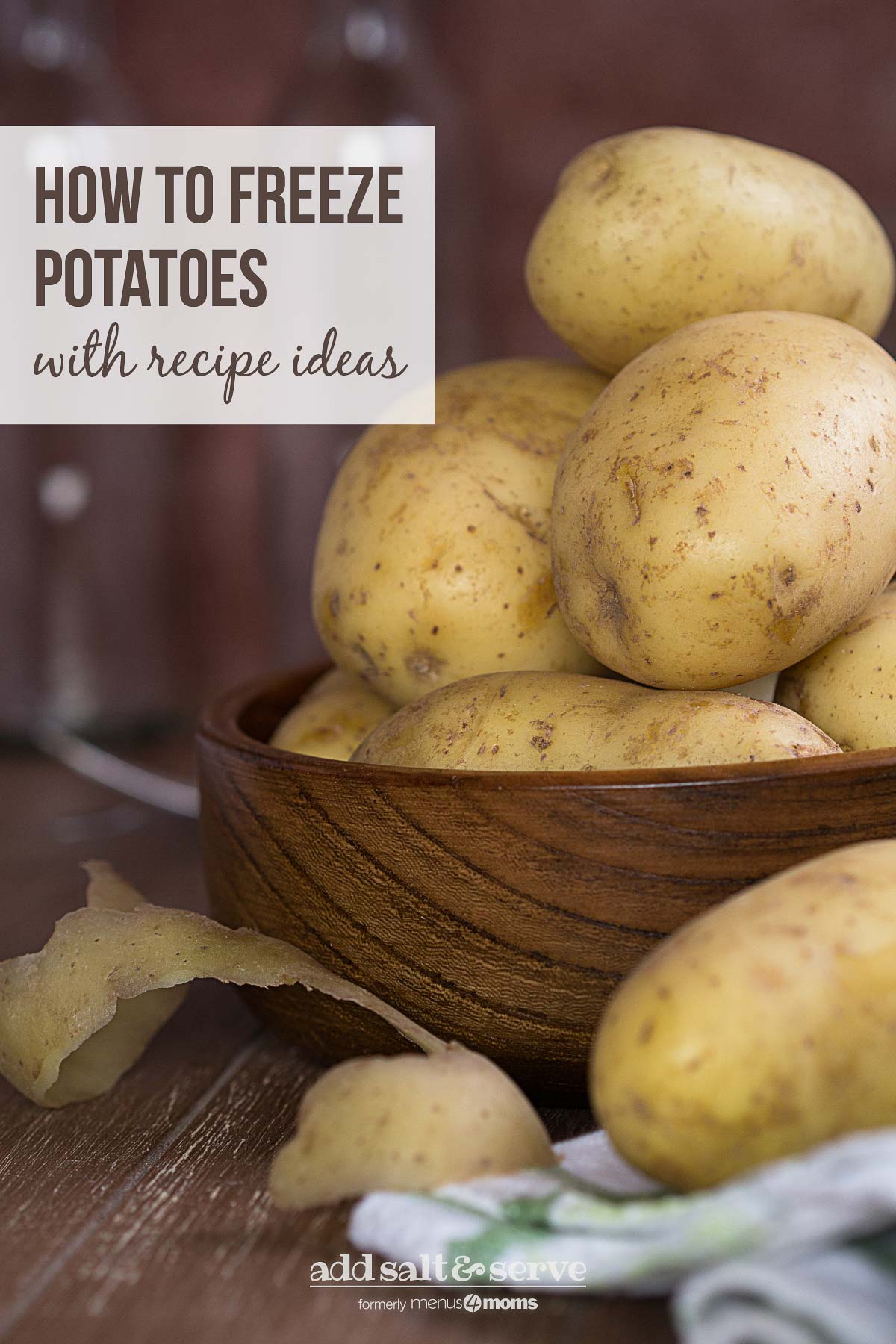
Can you freeze potatoes?
Many people are surprised that potatoes can be frozen because they assume that potatoes don't freeze successfully. I assumed the same thing at first, but after years of experimenting I've found that they are one of the easiest and most versatile foods in my repertoire.
You cannot successfully freeze raw potatoes, they must be cooked first (raw potatoes will turn black if frozen). Some people do blanch their potatoes before freezing and finish cooking after they thaw. Most prefer to cook and freeze. Part of this is personal preference, part will be the recipes you use.
You may decide to handle yours differently but here's what I do. This is not intended to be a plan for you to follow exactly. It is a basic skeleton to guide you through the procedure but, because every family is different, you will choose your own recipes to use in the plan.
Step 1: Prepare potatoes as whole, wedges, French fries, mashed, and riced
Whole potatoes.
- Turn the oven on and let it preheat while you're preparing the potatoes.
- Scrub the potatoes, pierce them, and sort them by size.
- Place some of medium and large potatoes by size on parchment-lined baking sheets and start baking. The large size will take an hour or more at 400ºF; the smaller ones will take a little less time.
- Reserve the remaining medium and large potatoes for oven baked fries and potato wedges.
Wedges.
- For wedges, cut unpeeled medium sized potatoes into 6-8 wedges lengthwise.
- Coat them with olive or canola oil. Don't use a lot, just enough to coat.
- Add whatever spices you wish and toss until evenly coated. I add a little sugar to the spices to help brown and crisp the wedges.
- Place on non-stick baking sheets or baking sheets lined with parchment paper; bake at 400ºF for 30 minutes.
- Place on brown paper bags or paper towels to cool.
- Place on clean cookie sheets and freeze solid.
- Place in labeled freezer bags and return to the freezer.
Oven fries.
- For oven fries, use the reserved large potatoes, peeling or not as you wish.
- Cut into fries. I use ½" fries; the size of your fries will determine your baking time.
- If your fries are not super-crisp, cover them with ice water and let them set for 45-60 minutes; drain, dry well.
- Toss with olive or canola oil, add spices and sugar and toss again.
- Place in a single layer on a baking sheet sprayed with non-stick spray or a parchment-lined baking sheet and bake at 475ºF for 20 minutes.
- Place on brown paper bags or paper towels to cool.
- Place on clean cookie sheets and freeze solid.
- Place in labeled freezer bags and return to the freezer.
Mashed potatoes.
I use the small potatoes to make mashed potatoes. There are two ways to do this. If the skins are in good shape, and I want to use them to make potato skin appetizers, I use this method:
- Bake them in the oven like the larger sizes.
- When they come out I cut them in half (the long way) and scoop the flesh out into a bowl.
- I place the skins on a baking sheet, fill with whatever additions I want (not sour cream, it tends to separate and become watery when frozen by itself), flash freeze, wrap well, label, and return to the freezer.
- If I want very crispy potato skins, I simply freeze them empty.
If the skins are not in good enough shape to use, or if I am using Yukon Gold potatoes, I use this method:
- Boil them in their skins, drain, cut in half (the short way), and place in a ricer*, cut side down. Rice the potatoes.
- I don't have to take time to peel or mash them; the ricer does both for me in one motion.
- Add whatever ingredients you wish to add to the pulp (sour cream, cream cheese, butter, salt and pepper, garlic, onion, other seasonings, etc).
- Freeze in meal-sized portions, making sure to wrap well and label. (Note that I do add sour cream before freezing when it is mixed with other ingredients.)
*A ricer is a very handy little kitchen utensil that allows you to make mashed potatoes without really mashing them. It is composed of a cylinder about 2 ½" high and 3 ½" wide. The bottom of the cylinder looks like a sieve and the top is open. The handle is hinged and the top part has a flat disk attached that fits into the top of the cylinder.
Place your cooked potato half in the cylinder, cut side down, and squeeze. The pulp goes through the sieve and the skin remains in the cylinder. It lets you make mashed potatoes with a nice, somewhat lighter texture than if you mashed them (Unless, of course, you stir them to death after you've riced them.) You can also just put whole peeled cooked potatoes in it. Think over-sized garlic press. You can find them in most kitchen supply sections.
Step 2: Use the whole potatoes to make twice baked, loaded, and shredded
As the larger potatoes come out of the oven, I let them cool enough to handle.
Twice baked potatoes. I pick out the nicest looking medium sized potatoes for twice baked potatoes. Don't let them get too cool or it will be hard to scrape the pulp out of the skin. Slit length-ways. While still warm, scoop the pulp out, leaving a thin layer of pulp in the skin. Mash the pulp up and combine with anything you wish.
I usually add sour cream or cottage cheese (to make the filling creamier and a little tangy) followed by seasonings such as finely minced onion or garlic (or use the powders), dill weed, or celery flakes. I've also varied them by using a little Italian seasoning or taco seasoning.
If you use dried herbs, make sure the pulp is moist enough to rehydrate them; add a little milk if you need to. Refill the skins with the pulp, flash freeze, wrap, label, and return to the freezer.
Baked and loaded potatoes. I pick out the nicest looking large potatoes for baked potatoes or loaded (stuffed) potatoes. After they have cooled completely, I place them on a baking sheet, flash freeze, bag, label, and return to the freezer. I don't care for the texture of microwave baked potatoes but previously oven baked potatoes are fine when they've been re-warmed in the microwave.
For loaded potatoes, use large potatoes and freeze them whole after they have been baked. (If you wish, you can make the loaded potatoes first and freeze them). Slit lengthwise and place in individual serving bowls. Possible toppings are limited only by your imagination. We especially like:
- Taco - taco flavored crumbled ground beef, chopped tomatoes, chopped onion, shredded lettuce, sour cream
- Ham and Cheese - shredded or coarsely ground ham, shredded Swiss cheese
- Pizza - Crumbled Italian sausage, shredded Mozzarella cheese, green pepper, mushrooms, pizza sauce (can also use pepperoni, shredded chicken, or hamburger)
- Roast Beef - shredded roast beef, shredded Cheddar cheese, mushrooms
- Chili and Cheese - canned or made chili (not too soupy), shredded Cheddar, sour cream
- BLT - crumbled crisp-fried bacon, chopped tomatoes, and shredded lettuce with a little sour cream if you want
Shredded potatoes. The remaining medium and large sized potatoes (with the skins that didn't look so good) are peeled, shredded or chopped, and used for things such as potato pancakes, hash brown casseroles, and soups.
Really, anything is fair game. Just let your imagination run wild.
General potato-freezing instructions
As always when you're stocking your freezer, proper preparation is key or all your hard work will be for naught. Here's how to prepare potatoes for freezing.
Preparing for the freezer
- Wrap everything well, getting out as much air as possible.
- Use freezer wrap, freezer containers, freezer bags, etc. If you use supplies not designed for the freezer (like storage bags) they will not protect your food as well.
- Label everything. Even though you're sure you'll remember what it is, in 3 months when you pull a solid chunk of something out of the freezer with no label, you'll be serving pot luck for supper. On the label, include the date you froze it, the name of the dish, any reheating and serving instructions you will need, and anything else you think you'll need to know. I include nutritional information on mine.
- Place the label on the outside of the bag or container before you place the food in it; most labels will not adhere properly if done after the food is placed in the bag.
Freezing potatoes
Individual quick freezing. For things like the loaded potatoes, twice-baked, fries, wedges, potato pancakes, etc., I individually quick freeze. Commercial food producers flash freeze their products to maintain the best possible quality.
They place their finished products in a super cold freezer that will freeze them solid in a matter of a few minutes. That's where the term actually originated.
Non-commercial freezers can't flash freeze, so we improvise. Place each item on a cookie sheet, making sure there is space between them, and place in the freezer until they are frozen solid (a minimum of several hours for most things). Then you can either place them in a freezer bag without further wrapping or you can wrap them individually before placing them in the bag.
Either way, you can remove just the number of servings you want. Manufacturers call it IQF (Individually Quick Frozen).
Casseroles. For casserole type dishes there are several ways to freeze. If you freeze it before baking, it can be placed in a large freezer bag and frozen. You can bake the casserole, cut in serving pieces, freeze, wrap, and bag.
You can leave the casserole in the dish (either cooked or uncooked), wrap well, and freeze. You can line your baking dish with plastic wrap or aluminum foil, fill, freeze, pop out of the dish, wrap, and return to the freezer.
Mashed potatoes and soups. For mashed potatoes and soups, divide into meal-sized portions, place in a labeled freezer container or bag, and freeze.
Cooking potatoes from frozen
Most of the potato dishes I freeze are very forgiving and you can reheat them just about any way you find convenient. I frequently use the microwave. I use the thaw feature for 2-3 minutes and then heat on full or partial power.
It will depend on what the item is and what the wattage of your microwave is; mine is 1100 watts so it goes pretty fast. Just play around with yours a little, figure out what works best and when you're satisfied, make a note on your recipe so you don't have to guess the next time.
Twice baked potatoes. Twice baked potatoes I thaw for about a minute in the microwave and then stick them in a 350°F toaster oven.
Oven fries and wedges. Oven fries and potato wedges are only partially cooked when I freeze them so they need to go in a 450°F oven for an additional 30 to 45 minutes, turning halfway through. Cooking time will depend on the size of the fries or wedges.
Use a non-stick baking sheet, a baking sheet sprayed with non-stick cooking spray, or a baking stone. The oven fries can also be finished in a deep-fryer.
Potato skins. To serve filled potato skins, bake in the toaster oven or oven at 400°Fs. Remove from oven and add anything else you may want such as sour cream, cheese, green onions, etc. For the crispy skins that you froze empty, bake at a high temp or place them under the broiler until they crisp up, fill and place back in the oven to heat through and melt the cheese.
Casseroles. Casseroles can be cooked from frozen but it takes about an additional 30-60 minutes or so (depends on how big and how dense the casserole is). I prefer not to do it that way because of the extra energy it uses.
If I'm cooking an entire casserole I prefer to thaw in the refrigerator first (it takes 1-2 days, depending on the casserole.). If you froze it and removed it from the dish, remove the wrapping, place back in the same dish, place in the refrigerator to thaw, and bake. If you froze the casserole in a freezer bag, it has to be thawed, placed in the casserole dish, and baked.
Most of the time, I cook the casseroles before freezing, divide into serving size portions, flash freeze, wrap, place in a labeled freezer bag, and return to the freezer. Since there are only two of us now and we are constantly watching our diets, this is perfect portion control. If I'm heating single portions, I do it in the microwave from frozen (thaw first, then finish heating). Shepherd's Pie is a great way to use mashed potatoes.
Baked potatoes. Baked potatoes can be thawed in the microwave and then heated or they can be thawed for a minute or 2 in the microwave and then finished in the toaster oven or regular oven at whatever temperature works for the rest of the dinner you're serving. The oven method crisps up the skin better than the microwave. The amount of time will depend on the size of the potatoes.
Mashed potatoes. Mashed is just heated in the microwave and stirred. If you wish, they can also be heated on the stove but do it on a low temp and remember to stir several times as they thaw and heat.
Soups. Soups are either heated from frozen in the microwave or on top of the stove. Just stir a few times as it thaws and heats. Try Hash Brown Potato Soup with your frozen potatoes for a quick, delicious meal.
Loaded potatoes. Loaded potatoes are defrosted for a couple minutes in the microwave and then heated in the microwave or in the toaster oven or regular oven at 350°F until heated through.
Potatoes are one of the most versatile foods we have and one of the easiest to prepare for the freezer. If you don't have a large block of time, it's easy to prepare just a few dishes (or even one) at a time. Just think of the satisfaction you'll have when all those entrees and side dishes are in the freezer and available at a moment's notice.
© Wanda A. Carter; Used by permission


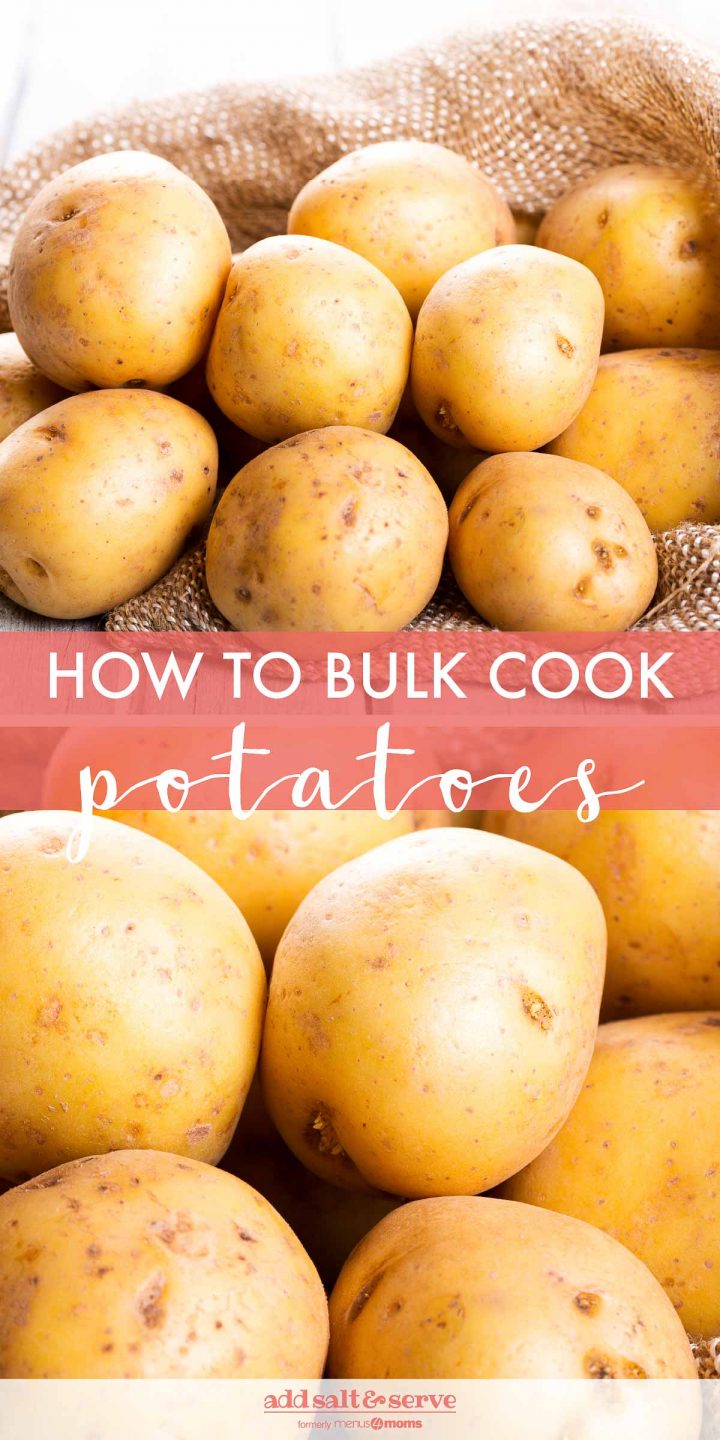
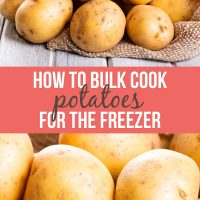
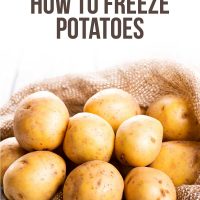
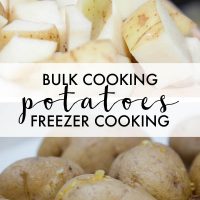
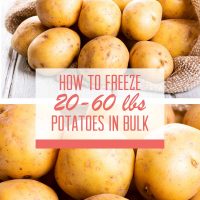
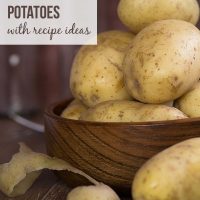
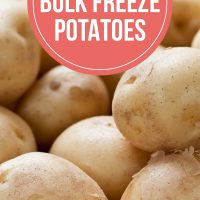
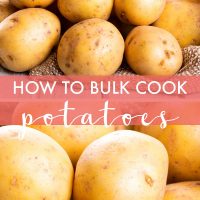
Linda Cameron
How long can these be kept in the freezer?
Wanda Carter
Hi, I'm Wanda. I hope you like this system. It served me well for many years.
I always plan on using them within a year but I can't emphasize enough how important it is to package them for the freezer correctly. I used to use a vacuum sealer for many things; I even wore one out, but they are not the only way to do it. As the number of people I was cooking for decreased, I switched my method. I still package in single portions because I now live alone and during the pandemic there really isn't any entertaining to prepare for.
I wrap in two layers to prevent freezer burn. The first layer is molded as closely to the food as possible and I don't use freezer-grade materials for this. Freezer-grade materials are not pliable enough for this. Freezer burn occurs when air touches the food and desiccates (dries) it. I'm sure you've heard about placing a piece of plastic wrap over ice cream before closing the container if you're not planning on using it right away. This functions the same way. I use Baggies, mainly the sandwich size, but they are also available in the gallon size. Around here Baggies are becoming more difficult to find so I have also used regular sandwich bags. I stay away from zipper-type bags because the zipper strip makes it difficult to mold it tightly to the food. Plastic wrap or aluminum foil both work well. Wax paper has never really worked well for me; it just doesn't stay where I put it and form a tight seal.
The second layer MUST be freezer grade material. For this I usually use zipper-type bags but there are also numerous other options available, such as freezer grade plastic containers and glass jars. Just make sure that whatever you choose, the closure is secure. I love saving money when I can on generics but this is one area where I don't. The name brands bags are generally made of thicker material and their zippers stay put and don't separate. I save money by washing and reusing them (unless they were used with raw meat).
I've used various dishes after the initial year and they have tasted just fine. I'm like everyone else, even with the best of planning, inevitably there will be a package that sometimes appears after hiding in the deep recesses of my freezer for way too long and if it looks fine, I use it. The one year limit also assumes you have your freezer set at 0 degrees (use a freezer thermometer to assure the setting is accurate.).
HeidiM
I'm really excited about this! I'm going to do Once a Month Cooking soon, but was a bit nervous that I would have PLENTY of entrees, but not enough side dishes. These ideas look great!
lisa
I was just wondering how you reheat the wedges or fries and at what temp for how long?
thank you
Mary Ann
Hi Lisa - I usually reheat similar to the way I would reheat frozen fries from the store, at about 450 degrees. The time would depend on the quantity, but between 12-20 minutes.
yvette
This really sounds great, practical and delicious. I´d love to be able to cook and prepare like this. Only, I don´t dare to start a project like this, since I would have no clue how long it would take. Does this take a full morning? How many kilo´s of patatoes do you use? Do you make a monthsupply? I´d be very interested...
Mary Ann
Hi Yvette - This post was reprinted with permission from Wanda Carter, but she is not a regular contributor on the blog and probably won't see your question. She doesn't put exact amounts because it really depends on how much you want to do. You can buy and prepare as many or as few potatoes as fits your needs. Wanda buys in 20 lb. increments, which would be around 9 kilos. She mentioned that she often buys up to 60 lbs. when they are on sale, so that would be around 27 kilos. That is a LOT of potatoes and would likely take all day to prepare. The bottom line is that you just have to decide how much you want to do of each dish and purchase to that scale. If you decide to prepare the potatoes, let us know how it goes!
Wanda
Hi Yvette,
I just saw your question (I've had some major health issues during the past year and haven't been on the computer much.) but I wanted to let you know that Mary Ann was right on target with what she told you. If I'm only doing 20# I figure on about 3 hours. I have a temperamental oven and I have better luck only baking 15# at a time. For 60# I plan on 5-6 hours. A lot will depend on how complicated your recipes are. Of the ones I do, the French fries and the twice baked are probably the most time consuming. I always freeze a good amount of the potatoes whole and that takes no prep time, just some cooling off time before I stick them in the freezer. If I'm doing a lot of casseroles, that adds to the time because I bake them before freezing in portion sizes. If you want to shorten your prep time, cook your potatoes first, then assemble your dishes like casseroles and soups, and freeze before cooking. With my current health issues it has been difficult to stay on my feet for lengthy periods so I do short sessions with just 1 or 2 potato dishes at a time. And having well stocked freezers has been a life saver when I haven't been able to cook at all.
Hazel
Hiya, I've just read your blog about freezing potatoes - firstly, I'm sorry you have been unwell - been there myself over the last three years and the food that I have cooked and prepared when able, then frozen, has been a great help. I, too, freeze potatoes. We didn't like the roasted ones much but the mashed potatoes were great and re-heated either in the oven (sometimes with grated cheese on top) and sometimes in the microwave. I am just about to try to do some fried potato skins - I regularly have family over and I'm not in the best health to do too much at a time so it becomes a military operation - lists to do, to make, to buy, etc etc. I do hope you are feeling better - I've just had my final clear CT scan after three years so am looking forward to many freezing years. God bless. x